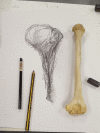Twelve tips for implementing artistic learning approaches in anatomy education
- PMID: 38406474
- PMCID: PMC10885264
- DOI: 10.15694/mep.2017.000106
Twelve tips for implementing artistic learning approaches in anatomy education
Abstract
This article was migrated. The article was marked as recommended. To enhance learning and maximise student satisfaction while simultaneously optimising costs and resources within the modern context and environment of integrated anatomy education, it is vital that innovative methods of delivering learning and teaching are considered for implementation into medical curricula. The development of learning processes including observation, visualisation, haptic reasoning and visuospatial ability are strongly associated with the use of artistic approaches. In addition to being crucial for medical student learning of anatomy and other life sciences, such skills are also relevant for training in surgery, clinical observation and diagnosis. The twelve tips outlined here have been identified with the intention of providing guidance for anatomy educators aiming to incorporate innovative creative and artistic approaches into their own teaching practice within medical curricula. These proposals are underpinned by educational theory and recent research that has investigated artistic learning methods in medical education. Recommendations are also based on our personal experiences from both the undergraduate student point of view as well as the academic educator perspective with respect to the usage of creative and artistic learning approaches in anatomy education at Newcastle University.
Keywords: Anatomy; Artistic learning methods; Undergraduate medical education.
Copyright: © 2017 Keenan ID et al.
Figures




Similar articles
-
Student and educator experiences of maternal-child simulation-based learning: a systematic review of qualitative evidence protocol.JBI Database System Rev Implement Rep. 2015 Jan;13(1):14-26. doi: 10.11124/jbisrir-2015-1694. JBI Database System Rev Implement Rep. 2015. PMID: 26447004
-
Pandemic-Era Digital Education: Insights from an Undergraduate Medical Programme.Adv Exp Med Biol. 2023;1397:1-19. doi: 10.1007/978-3-031-17135-2_1. Adv Exp Med Biol. 2023. PMID: 36522590
-
Predictors of confidence in anatomy knowledge for work as a junior doctor: a national survey of Australian medical students.BMC Med Educ. 2018 Jul 31;18(1):174. doi: 10.1186/s12909-018-1280-5. BMC Med Educ. 2018. PMID: 30064431 Free PMC article.
-
The role of 3D printing in anatomy education and surgical training: A narrative review.MedEdPublish (2016). 2017 Jun 6;6:92. doi: 10.15694/mep.2017.000092. eCollection 2017. MedEdPublish (2016). 2017. PMID: 38406430 Free PMC article.
-
Integrating 3D Visualisation Technologies in Undergraduate Anatomy Education.Adv Exp Med Biol. 2019;1120:39-53. doi: 10.1007/978-3-030-06070-1_4. Adv Exp Med Biol. 2019. PMID: 30919293 Review.
Cited by
-
Concluding Commentary. Life Sciences in an Integrated Medical Curriculum: Continuing the Conversation.MedEdPublish (2016). 2017 Jun 23;6:114. doi: 10.15694/mep.2017.000114. eCollection 2017. MedEdPublish (2016). 2017. PMID: 38406472 Free PMC article.
References
-
- Ausubel D. P.(2012). The acquisition and retention of knowledge: A cognitive view.( 1st Edition ed.): Springer Science & Business Media.
LinkOut - more resources
Full Text Sources

